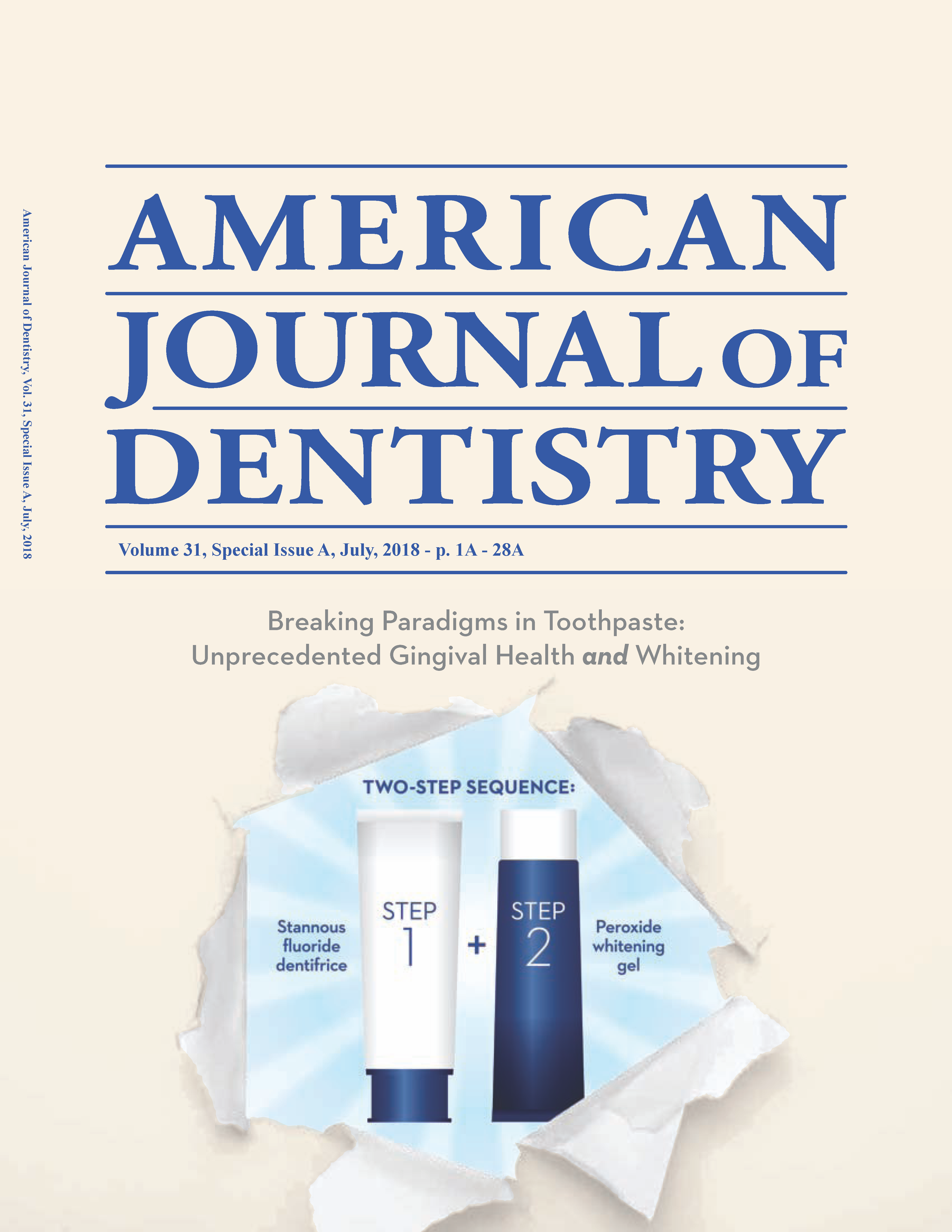
July 2018 Abstracts
_______________________________________________________________________________________________________________________________________________________________
Editorial
_______________________________________________________________________________________________________________________________________________________________
A
two-step stannous fluoride dentifrice and whitening gel sequence
The dramatic growth and impact
of tooth whitening worldwide has raised patients’ awareness of the appearance
of their smile. The introduction of whitening strips in 2000 played an
appreciable role, expanding access to an increasingly broad population. Some years
later, the whitening concept increased to include more dentifrices developed
for esthetic reasons.
At the same time, gingival
health is even more important over the long-term and the prevalence of
gingivitis remains high. The currently recognized gold standard
chemotherapeutic treatment, chlorhexidine, has several esthetic drawbacks that
limit patient compliance, and consequently effectiveness. Recognizing the wide-spread
need for an acceptable and efficacious gingival health therapy, in tandem with
patients’ growing desire for whiter teeth, researchers designed a novel
two-step system to meet both objectives.
This special issue of the
American Journal of Dentistry highlights important research findings on gingi-val
health, tooth whitening and safety associated with use of a unique two-step
hygiene sequence: stannous fluoride dentifrice followed by hydrogen peroxide
whitening gel. The research comes from diverse clinical settings.
This special issue of the
American Journal of Dentistry represents one of the largest collections of
clini-cal research on this two-stage protocol. The randomized controlled trials
described herein support its significant gingival health and whitening
outcomes. Such diverse testing, with respect to populations, sites and controls,
provides important evidence of the merits of the two-step method. As you will see, this novel sequence shatters
the long standing paradigm of therapeutic efficacy and esthetic negatives.
We hope you will find these
papers interesting and educational. The Journal thanks Procter & Gamble,
the manufacturer, for sponsoring this Special Issue.
Franklin García-Godoy, DDS, MS, PhD, PhD
Editor
_______________________________________________________________________________________________________________________________________________________________
Special
Issue Introduction
_______________________________________________________________________________________________________________________________________________________________
Clinical evidence on a unique two-step stannous
fluoride dentifrice
Paul A. Sagel, bsche & Robert
W. Gerlach, dds, mph
Abstract: Purpose: Recently, a unique two-step product was introduced that includes sequential use
of a novel 0.454% stannous fluoride dentifrice followed by a 3% hydrogen
peroxide whitening gel. The technology targeted advanced gingival health
benefits plus esthetic benefits such as tooth whitening. The two-step sequence
has unique brushing instructions to maximize the efficacy of each step; the
stannous fluoride dentifrice is used for 1 minute of brushing followed by 1
minute of brushing with the hydrogen peroxide gel. This two-step sequence has
been studied in numerous clinical trials over a series of years. This comprehensive
program included different populations and sites, endpoints and time points,
with responses measured versus different positive and negative research
controls. A total of six clinical trials are reported herein. Outcomes from
this research program demonstrate the significant gingival health efficacy of
the two-step product, providing therapeutic efficacy comparable to
chlorhexidine, and its positive impact on plaque, tooth stain and breath odor. (Am J Dent 2018;31:4A-6A).
Clinical significance: This unique dentifrice/gel
sequence delivers a combination of advanced gingivitis efficacy with
significant stain reduction – benefits that will positively impact oral health
as well as patient compliance.
*: Mr. Paul A. Sagel, The Procter & Gamble Company, 8700 Mason-Montgomery
Road, Mason, OH 45040 USA. E-*: sagel.pa@pg.com
_______________________________________________________________________________________________________________________________________________________________
Special
Issue Article
_______________________________________________________________________________________________________________________________________________________________
Initial evidence of two-step dentifrice/gel sequence
effects on health:
Robert W. Gerlach, dds, mph & Paul A. Sagel,
bsche
Abstract:
Purpose: Health-related outcomes from three randomized controlled trials represented the
initial research on the feasibility of novel, sequential oral hygiene with a
stannous fluoride (SnF2) dentifrice then hydrogen peroxide (H2O2)
whitening gel. Methods: One
crossover and two parallel clinical trials were conducted independently.
Objectives varied, with individual studies assessing short, intermediate or
longer-term outcomes from breath, dental plaque or gingivitis, respectively.
Treatments were randomly assigned, and blinded test kits were dispensed
containing either: 1) a two-step 0.454% SnF2 dentifrice and then a 3%
H2O2 whitening gel sequence and instructions specifying
1+1 minute sequential brushing (experimental); or 2) 0.76% sodium
monofluorophosphate dentifrice (Colgate Cavity Protection) and instructions for
twice daily use (control). Standard methods were used to measure efficacy
(volatile sulfur compounds, plaque area coverage or gingival bleeding) and
safety (clinical examination and interview), and to compare treatment
responses. Results: Overall, 165
subjects participated in the three trials. Relative to baseline, only the
experimental group exhibited significant (P< 0.05) improvements at initial
and subsequent timepoints in each trial. Between-group comparisons showed
significant (P< 0.05) 30-45% reductions in breath malodor (VSC), plaque (area%) and gingivitis (bleeding sites) favoring the
experimental group. Adverse event occurrences were infrequent, mild in
severity, and unrelated to dropout. (Am J
Dent 2018;31:7A-12A).
Clinical significance: Important health-related
outcomes from three initial clinical trials established the feasibility of
sequential brushing with a two-step 0.454% SnF2 dentifrice and then a
3% H2O2 whitening gel.
*: Mr. Paul A. Sagel, The Procter
& Gamble Company, 8700 Mason-Montgomery Road, Mason, OH 45040 USA. E-*: sagel.pa@pg.com
_______________________________________________________________________________________________________________________________________________________________
Special
Issue Article
_______________________________________________________________________________________________________________________________________________________________
Randomized controlled trial evaluating concurrent
gingivitis and stain
Pejmon Amini, dds, Alborz
Amini, bsc & Robert W. Gerlach, dds, mph
Abstract: Purpose: A randomized controlled trial was conducted to evaluate
the clinical efficacy of a two-step dentifrice/whitening gel oral hygiene
sequence on natural gingivitis and extrinsic stain. Methods: The population consisted of healthy adults with clinical
evidence of gingivitis and extrinsic stain. Consent, demographic information
and clinical measurements were collected, after which subjects were randomized
to treatment. Eligible subjects were dispensed blinded test kits containing
over-labeled two-step 0.454% SnF2 dentifrice then 3% H2O2 whitening gel sequence or a regular 0.76% NaMFP dentifrice control (Colgate
Cavity Protection), plus a regular soft manual toothbrush and instructions for
use. Efficacy was assessed blind-to-treatment using the Gingivitis Bleeding
Index (GBI) measured whole-mouth and the composite Lobene Stain Index (LSI)
measured on the anterior dentition. Treatments were compared at Week 1 and Week
3 versus baseline for ΔGBI and ΔLSI using a two-sided 5% level of
significance. Results: A total of 61
subjects with a mean (SD) age of 33.4 (12.0) years were enrolled. Overall
baseline means (SD) were 0.16 (0.05) for GBI and 1.30 (0.94) for LSI. After 1
week, only the two-step 0.454% SnF2 dentifrice then 3% H2O2 whitening gel sequence demonstrated significant (P< 0.0001) reductions in
both gingivitis and stain. Adjusted means for the changes with the
dentifrice/gel sequence and control were –0.055 and –0.001 for ΔGBI, and
–0.619 and –0.095 for ΔLSI, with groups differing significantly (P<
0.0001) on gingivitis and stain improvement. Outcomes at Week 3 were generally
similar, with groups differing on bleeding and stain. Treatments were generally
well-tolerated. (Am J Dent 2018;31:13A-17A).
Clinical significance: In a randomized controlled
trial, use of a two-step 0.454% SnF2 dentifrice then 3% H2O2 whitening gel sequence yielded concurrent improvements in gingivitis and stain
compared to regular oral hygiene.
*: Dr. Pejmon Amini, Silverstone
Research Group, 6707 West Charleston Blvd., Suite #4, Las Vegas, NV 89146 USA.
E-*: pamini@silverstoneresearch.com
_______________________________________________________________________________________________________________________________________________________________
Special
Issue Article
_______________________________________________________________________________________________________________________________________________________________
Post-prophylaxis gingivitis prevention with two-step
stannous fluoride
Cristina Garcia-Godoy, dds,
mph, ccrp, James Rothrock, bs, Nataliya Gurich, phd, Mary Kay Anastasia, ba
Abstract: Purpose: To assess use of a two-step
dentifrice/gel sequence versus chlorhexidine gluconate mouthrinse on gingivitis
prevention after dental prophylaxis. Methods: A 12-week, randomized controlled trial was conducted to compare the effectiveness
and safety of a two-step dentifrice/gel sequence to a positive control in
healthy adults with established gingivitis. After informed consent, gingivitis
and stain levels were assessed by clinical examination. Eligible subjects
received a dental prophylaxis and were randomly assigned to twice daily
unsupervised use of either (1) two-step oral hygiene sequence: 0.454% stannous
fluoride dentifrice followed by 3.0% hydrogen peroxide whitening gel for the test
group; or (2) 0.12% chlorhexidine gluconate oral rinse and 0.76% sodium
monofluorophosphate dentifrice for the control group. Clinical measurements of
gingivitis bleeding sites and tooth stain area/intensity were collected after
4, 8 and 12 weeks use, while safety was assessed via clinical examination and
oral status interview of the subjects. Results: A total of 44 subjects were enrolled and 35 completed the 12-week study. At
baseline, bleeding sites ranged from 10-33. After prophylaxis and assigned
treatment, both groups exhibited significant (P£ 0.0001) reductions in bleeding sites. Responses
were directionally better in the two-step sequence at all post-baseline
timepoints, with groups differing significantly (P < 0.05) at Week 8. Tooth
stain measurements demonstrated that the two-step dentifrice/gel sequence did
not contribute to any significant (P> 0.13) stain accumulation. In contrast,
stain accumulation was evident (P< 0.003) in the chlorhexidine group
beginning at the Week 4 visit. Adverse events were more common in the positive
control, and contributed to early termination. (Am J Dent 2018;31:18A-23A).
Clinical significance: Twice daily use of a two-step
stannous fluoride dentifrice and peroxide whitening gel sequence after
prophylaxis provided comparable or superior gingivitis benefits to chlorhexidine
gluconate rinse without the concomitant side effect of staining.
*: Dr. Cristina Garcia-Godoy,
College of Dental Medicine, Nova Southeastern University, 3200 South University
Drive, Ft. Lauderdale FL 33314, USA. E-*: cgarciag@nova.edu
_______________________________________________________________________________________________________________________________________________________________
Special
Issue Article
_______________________________________________________________________________________________________________________________________________________________
Safety and effectiveness of a two-step dentifrice/gel
sequence with
Mabi Singh, dmd, ms, Athena
Papas, dmd, phd & Robert
W. Gerlach, dds, mph
Abstract: Purpose: A randomized controlled trial was conducted to evaluate
the safety and effectiveness of a two-step dentifrice/gel oral hygiene sequence
in a vulnerable population. Methods: Prior to the research, institutional review was obtained for the protocol,
consent and advertising. The study targeted adults with medication-associated
xerostomia, because of the plaque accumulation and possible oral safety risks
seen in this population. Eligible subjects with a medication history and
measured hyposalivation were randomly assigned to one of two oral hygiene
groups: (1) a two-step 0.454% SnF2 dentifrice and 3% H2O2 gel sequence or (2) a regular anticavity toothpaste control. Test products were
dispensed with a regular manual brush in blinded over-labeled kits with usage
instructions. Subjects were evaluated at baseline and after 2 and 6 weeks of
test product use. Safety was assessed as adverse events from clinical
examination and interview. Digital plaque image analysis of the anterior facial
teeth measured fluorescein-disclosed daytime plaque levels, and unstimulated
saliva was collected over a 5-minute period in pre-weighed vials. Results: A total of 49 subjects ranging
from 31-80 years of age (53% female) were enrolled, and 45 completed Week 6.
Only the two-step dentifrice and gel sequence differed significantly (P<
0.005) from baseline on daytime plaque coverage, and salivary flow increased
significantly (P= 0.033) in that group as well. Between-group comparisons for
daytime plaque favored the two-step sequence with 41-46% improvements in plaque
control. At Week 6, adjusted daytime plaque means (SE) were 5.9 (0.7) and 10.0
(1.1) for the two-step and control groups, respectively (P< 0.004). Adverse
events were mild in severity, groups differed significantly (P= 0.02) on
occurrence, and events did not contribute to dropout. (Am J Dent 2018;31:24A-28A).
Clinical significance: In a randomized controlled trial
among a vulnerable population, use of an oral hygiene sequence comprised of stannous
fluoride dentifrice and a hydrogen peroxide whitening gel improved daily plaque
control without adversely impacting salivary flow or oral health.
*: Dr. Mabi Singh, Associate
Professor, Tufts University School of Dental Medicine, 1 Kneeland Street,
Boston, MA 02111 USA. E-*: Mabi_L.Singh@tufts.edu


